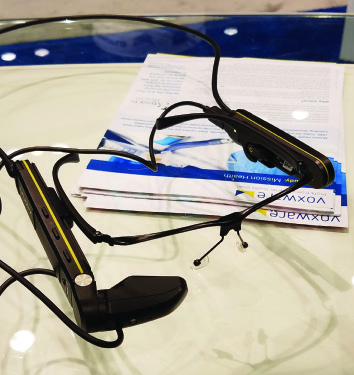State of Voice: Five Game-changing voice trends
From augmented reality to the “voodoo of voice” to the sunset of Windows mobile operating systems, here are five voice-related trends that are impacting warehouses and DCs right now.
In today’s high-velocity warehouses and DCs, voice-directed picking systems play an important role that goes beyond just order selection and product picking. Also used for receiving, put-away, replenishment, returns and cycle counting, “voice picking” or “pick by voice” creates a hands-free, efficient workflow that doesn’t require users to stop, read, scan, key-in information or jot down notes. Instead, they can focus on the work at hand.
Known for their ability to improve user productivity—even DCs with 99.9% accuracy before installing voice systems can reduce their picking errors by 25% or more, according to a study by Lucas Systems—and pick speeds, voice incorporates speech recognition and synthesis. These technologies work together to enable communication with the facility’s warehouse management system (WMS), thus ensuring a smooth, accurate flow of information. For example, a voice verification system can receive data from the WMS, transform that information into speech, and then instruct the picker to the specific item location within the warehouse and the quantity required. Like nearly all warehouse technologies, voice-directed picking has evolved right along with the facilities and functionalities that it supports. Here are the top voice-related trends that all warehouse and DC managers should be keeping an eye on:
1.) Voice is no longer just a “science project” for large companies
“We’re seeing a dramatic increase in demand in voice technology in general,” says Keith Phillips, president and CEO at Voxware. Go back in time, he adds, and the solution was really only on the radar screens of large organizations that could afford to implement it. Over the last few years, however, technology itself has improved (both in terms of easier deployment and ongoing support) while the cost of ownership has been reduced. “It’s no longer a science project,” says Phillips. “It’s a proven technology that works, and that can be implemented within about three months—from contract signing to the go-live date.”
These improvements have pushed up voice adoption and the proven implementations have made companies of all sizes more comfortable with the technology. “Companies that want to improve productivity and accuracy are turning to voice,” says Phillips. That interest level is not only being seen in the picking arena, but also in voice-related receiving, loading, replenishment, cycle counting and other DC activities. “With the growing adoption and success of the technology,” Phillips adds, “companies are now taking a much broader approach to voice implementations.”
 At least some of that expanding demand is being driven by e-commerce, omni-channel, and the increased levels of piece-picking and each-picking that are being managed in the modern-day warehouse or DC. “Companies need to be very efficient in these areas,” says Mark Wheeler, Zebra’s director of supply chain solutions, “to deal with today’s rapidly changing order volumes and distribution networks.”
At least some of that expanding demand is being driven by e-commerce, omni-channel, and the increased levels of piece-picking and each-picking that are being managed in the modern-day warehouse or DC. “Companies need to be very efficient in these areas,” says Mark Wheeler, Zebra’s director of supply chain solutions, “to deal with today’s rapidly changing order volumes and distribution networks.”
2.) The technology has become more “day labor-friendly.”
The labor market isn’t very friendly for warehouse and DC managers right now, particularly when it comes to securing day labor that needs to be able to get up to speed and working quickly. “A lot of our customers are dealing with high employee turnover,” says Wheeler. “There’s a lot of competition for labor, so having a technology tool that’s easy to learn and use has become an imperative in the typical DC.”
Day laborers present a particularly high hurdle, he says, and one that voice hasn’t historically addressed very well. That’s because employees had to go through “voice template training” to establish his or her unique manner of speaking. The process took time, and wasn’t very compatible for workers who needed to be up and running the same day (and, for just one day).
According to Scott Deutsch, president of Ehrhardt + Partner, North America, that has changed. In fact, he says voice technology (such as E+P’s Lydia voice solutions) has become much more “day labor-friendly” in that it allows a company to bring in a worker at 7 a.m. and have that person operating within five minutes. “From an ROI perspective, and assuming that you can train workers very quickly on how the floor is organized,” Deutsch says, “this completely changes the dynamics of voice adoption.”
3.) The “voodoo of voice” just isn’t a thing anymore
 Deutsch has been around voice long enough to remember a time when the technology was so complex it only attracted companies with huge workforces and deep pockets. “I call it the voodoo of voice,” he says, “and it’s rooted in the fact that the marketplace has always thought that voice is complex and that you need super expertise to implement it.” Deutsch says the technology vendors themselves are to blame for this stigma, which is now fading as a result of easier integrations and automated workflows that truly mirror a company’s business processes.
Deutsch has been around voice long enough to remember a time when the technology was so complex it only attracted companies with huge workforces and deep pockets. “I call it the voodoo of voice,” he says, “and it’s rooted in the fact that the marketplace has always thought that voice is complex and that you need super expertise to implement it.” Deutsch says the technology vendors themselves are to blame for this stigma, which is now fading as a result of easier integrations and automated workflows that truly mirror a company’s business processes.
“Our own voice product is seamless, easy to integrate and interfaces in real time/near real time,” says Deutsch, “thus allowing customers to gain quick value from it.” He says this evolution blends well with the basic mission of most warehouses and DCs that are operating in the e-commerce environment: To get small orders out the door as quickly and efficiently as possible. “The small-order business is exploding, and companies need to be able to handle it,” says Deutsch. “Voice really excels in this arena and helps companies deliver on their service commitments.”
4.) The sunset of Windows Mobile and CE could be painful
Anyone who was around for the Y2K bug remembers how it promised to cause computer hardware problems when Jan. 1, 2000 rolled around. And while it wasn’t exactly the “computer apocalypse” that a lot of people thought it would be, the so-called “millennium bug” caused a lot of anxiety and stress for businesses and individuals alike. Fast-forward to 2020 and companies may find themselves in a similar position three years from now when Microsoft officially ends support for its Windows CE and Mobile products.
“Virtually every mobile device in the DC that’s not on the Android platform will hit end of life in 2020,” says Ron Kubera, executive vice president and chief marketing officer at Lucas Systems. “Voice applications running on those devices are going to have to be refreshed or users will be working with hardware and operating systems that are no longer supported by Microsoft. That’s pretty scary.”
And despite the warnings being circulated about the looming Windows operating systems sunset, Kubera says a lot of warehouse and DC operators are unaware of it. “When I bring it up during conversation, many times it’s the first time someone is even hearing about it,” he says.
To avoid potential problems, Kubera says companies need to come up with a strategy. Understand the potential risks, he says, and realize that if a device needs its firmware changed—and if Microsoft is no longer supporting that specific operating system—then you may be stuck. Lucas, for example, develops the same voice applications on both the Windows and Android platforms, which means its customers can switch between the two, should they be impacted by the impending sunset.
“The majority of mobile applications that are running on Windows mobile devices today are going to have to be replaced or rewritten,” Kubera says. “That’s why it’s such a big issue and one that warrants attention now versus later.”
5.) Adding analytics and augmented reality to voice are real game-changers
Data analytics has taken center stage in business applications, where knowing and understanding historical data—and having it aggregated on a user-friendly dashboard—helps organizations make better forward-looking decisions. In the voice arena, Phillips says a growing number of customers are asking for analytical capabilities to further improve accuracy and productivity. “Once voice is implemented and positively impacting operations, the next logical questions are, ‘How do we become even more efficient?’’ says Phillips, “and, ‘How do we leverage this technology even more than we already are?’”
In most cases, the answers to those questions lie in analytics, or information that results from the systematic analysis of data or statistics. “We’ve been big proponents of using analytics with voice,” says Phillips. “We started about three years ago, and have continued to enhance and make new introductions in the analytics area since then.” In most situations, Phillips says companies that add analytics capabilities to their voice solutions can expect 10% to 15% productivity gains in their warehouses and DCs.
Add next-generation solutions like augmented reality (i.e., technology that superimposes computer-generated images on a user’s view of the warehouse or DC, thus providing a composite view) to the mix, Phillips says, and the business case for voice becomes even stronger. That’s because augmented reality has a direct impact on improving the accuracy of items as they are picked, packed and shipped out to customers.
“It’s no secret that the distribution side—not retail—determines the real customer experience,” Phillips adds. “You can have a great customer shopping experience on a Website, but when the box shows up on your doorstep damaged or filled with the wrong items, then that positive shopping experience goes down the drain pretty quickly.”
Companies mentioned in this article:

Article Topics
Magazine Archive News & Resources
Latest in Materials Handling
Lucas Watson appointed CSO for Körber’s Parcel Logistics business in North America Hyster recognizes Dealers of Distinction for 2023 Carolina Handling names Joe Perkins as COO C-suite Interview with Keith Moore, CEO, AutoScheduler.AI: MODEX was a meeting place for innovation Walmart deploying autonomous lift trucks at four of its high-tech DCs Coles shops big for automation Kathleen Phelps to join FORTNA as chief financial officer More Materials HandlingAbout the Author
Subscribe to Materials Handling Magazine

Find out what the world's most innovative companies are doing to improve productivity in their plants and distribution centers.
Start your FREE subscription today.
April 2024 Modern Materials Handling

Latest Resources










